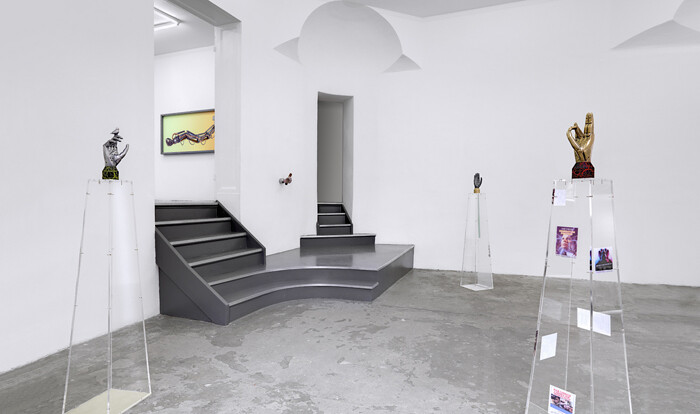It was in 1843 that Ada Lovelace, daughter of Lord Byron and a friend of Charles Babbage, sketched out a concept for machine calculations. Today she is considered the first computer programmer. Lovelace’s claim to fame comes as the first entry in a timeline that is given as a handout to accompany Aleksandra Domanović’s exhibition.
“The Future Was at Her Fingertips” reads the title of the show, which leaves us with two questions: one is a matter of time, the other of agency. As the future “was,” is it now over? Or did it never happen? Furthermore, having had it at her fingertips, did she ever manage to grab it? Or did she let it escape? One thing is certain: we know from the phrase that it was a woman’s future.
In 2012, Domanović did an interview with the Slovenian computer scientist Borka Jerman Blažič. Back in 1991, Blažič had registered the domain .yu and introduced the first Internet services to the then Yugoslavia. One year later, the country began to violently tear itself apart. Domanović was born in the former Yugoslavia, in the Serbian city of Novi Sad, but grew up in the part of the country which later became Slovenia, and in some way perhaps her having lived through a state falling apart geared her focus towards the rituals of power and ideological constructions of history. When she asked Blažič for other Yugoslavian contributions to the progress of science, she told Domanović about the so-called “Belgrade Hand,” a controllable prosthesis invented in 1963.
For her show, Domanović had the hand digitally rebuilt as a rigged 3D model, which allowed her to act out a variety of gestures. What we see in the gallery are four hands cast through a laser sintering process. Three of them sit atop obelisk-shaped plinths made of acrylic glass, a fourth is mounted on the wall. Two of the hands and the frame of a large ink-jet print displayed in the backroom are coated with a layer of “Soft-Touch,” a polyurethane-based coating that feels like an organic surface, almost like leather, and is commonly used in interiors, for example, of cars, but also for book covers. The framed print, Belgrade Hand on Minsky Tentacle Arm (2013), shows the hand mounted on an extended robotic arm. This limb without a body is set against a hazy background of sherbert lime, lemon, and orange. The appearance is both sensual and slick—situated between a Konrad Klapheck (German Pop) painting and an illustration in a magazine for nerdy engineers.
The whole assemblage of re-cast or rendered robot hands in shiny metal or coated with seemingly organic surfaces point to a cyborg fantasy that itself has become history. Domanović names Sadie Plant’s Zeros and Ones (1997) as a reference, but it has been sixteen years since that crucial text of the cyberfeminist movement appeared. Of course, the discourse did not end there (Rosi Braidotti’s 2013 book The Posthuman is just one recent example). But this is not the artist’s point. The exhibition takes an almost nostalgic or even romanticizing look back at early feminist attempts to imagine a technoid future. In this respect, the figure of the cyborg resembles the state of Yugoslavia: both futures did not take place.
That is, Domanović’s artworks render this Yugoslavian cyborg-complex in the same well-observed and yet detached attitude suggested in her earlier works dealing with the cultural heritage of the former Yugoslavia. Her documentary video Turbo Sculpture (2009–2012), for example, describes the public monuments erected in the 1990s, which put blockbuster heroes like Bruce Lee or Rocky Balboa and even Johnny Depp on a pedestal in the middle of several small town squares.
However, neither the figure of the cyborg, nor the imagination of Yugoslavia as a united multi-national state (nor new heroes, for that matter) live up to the promise of a better future. But it’s also not necessarily a future past. It lingers as an unfinished history, temporarily suspended in limbo.
The Belgrade Hand was known for a very simple automatic control mechanism. As soon as its fingertip came into contact with an object, it would automatically close. The phrase “the future was at her fingertips” is borrowed from Plant, referring to the untold number of switchboard operators from the 1930s onwards. Very literally, these women had the future at their fingertips, but it never played out in their favor. As switchboards were automated in the 1950s, the mostly female workers (who were actually referred to as “computers” at the time), lost their jobs, ironically, to what we now call computers.
But Domanović’s hand sculptures reach out to a much wider (time)frame. Two are linked to classic gestures of Christian iconography. One takes the shape of a Buddhist mudra and the other, made of solid Yugoslav chestnut and mounted on the wall, holds a relay runner’s baton. What looks like a random choice of gestures has one aspect in common: time, itself, is overcome here, be it through eternity, nirvana, or repetition.
Domanović’s timeline doesn’t end with the contemporary. It extends into the future. “2025 New Zealand is completely smoke free.” Just like that, for no reason, the artist replied when I asked her why she had included that detail. The last entry quotes Ray Kurzweil’s prediction: “2099 most conscious beings lack a permanent physical form.” Looking back from the end of the twenty-first century to our present day, one can imagine the same bewildered disbelief at a past future that looked so different from what came. In this respect, the relations between human and technical beings may turn into an amplified version of what happened to the people in Yugoslavia. Only this time it is intellectual (and not territorial) sovereignty that has been called into question. The Belgrade Hand, after all, may be an appropriate element to annex the future of both, as it endeavors to escape into timelessness.







